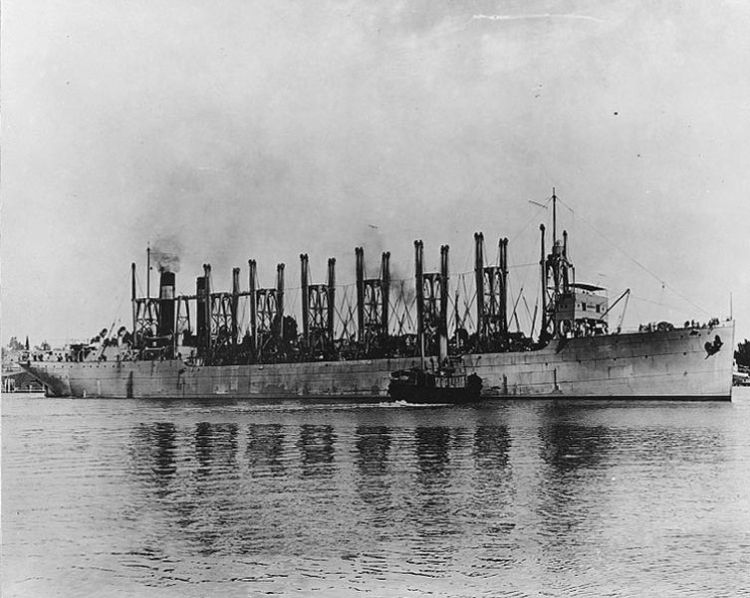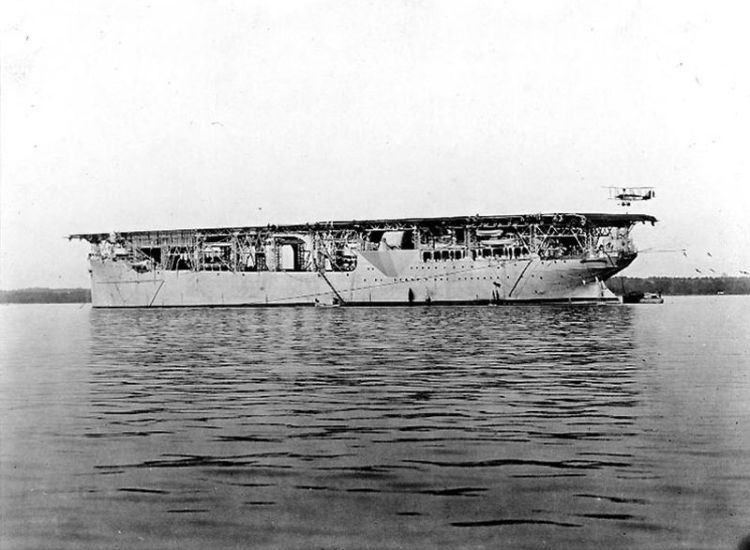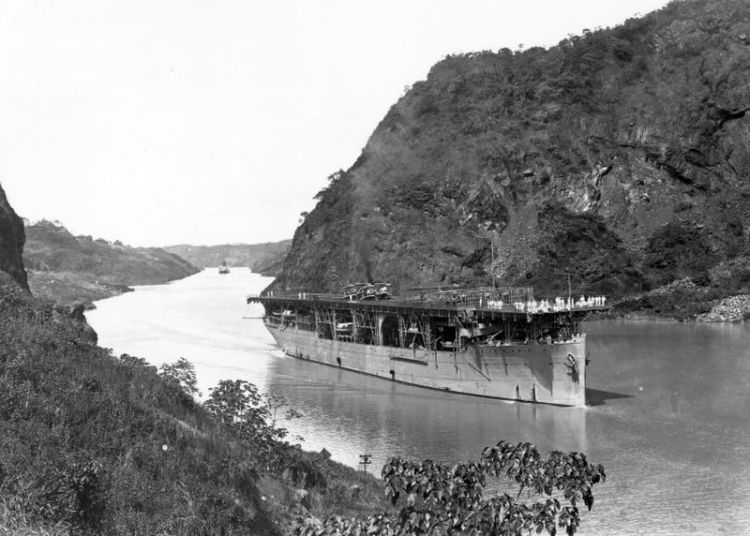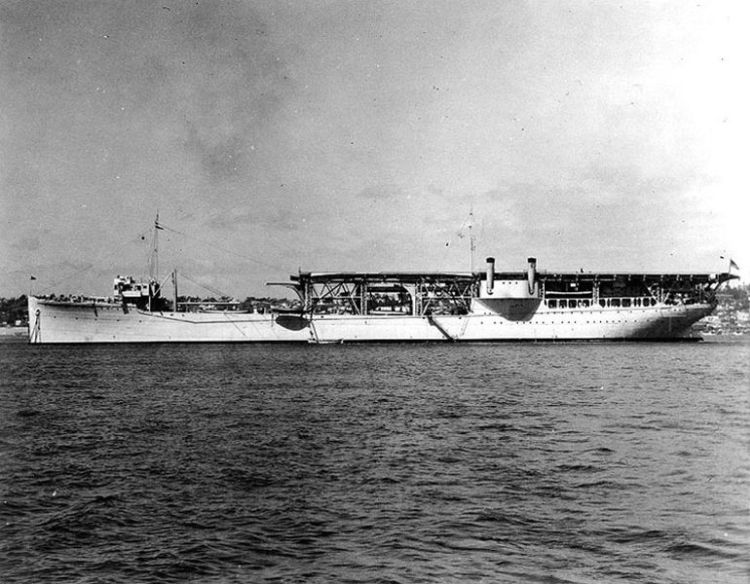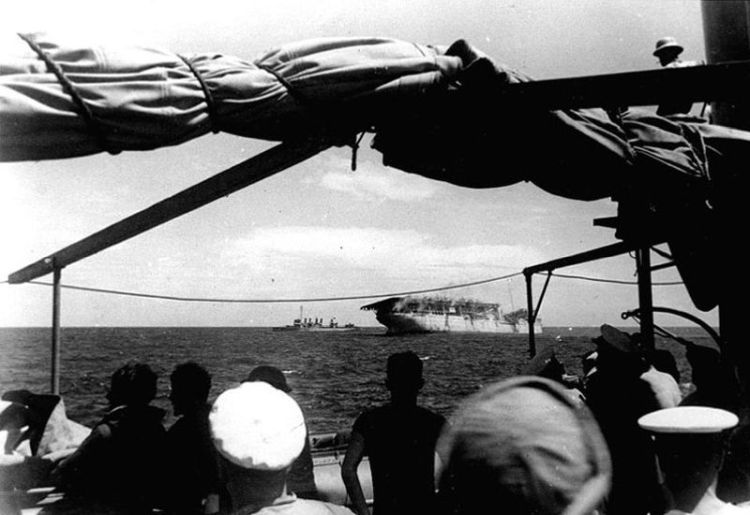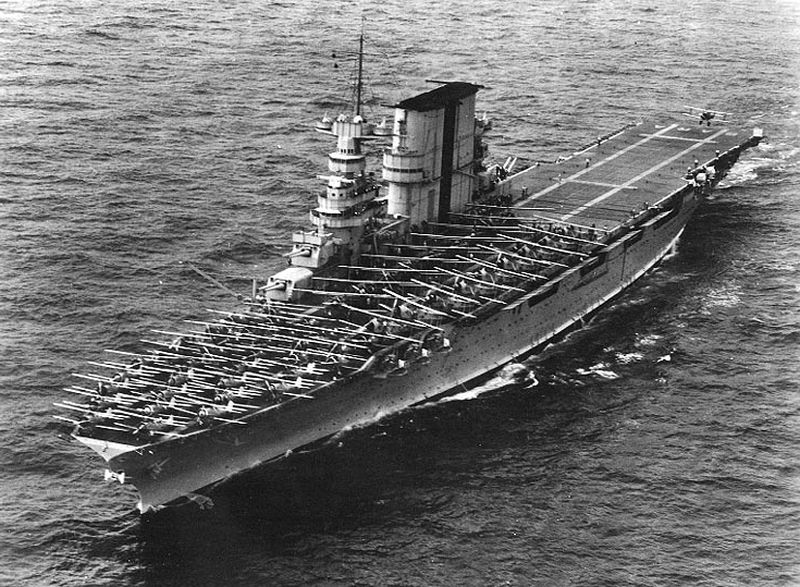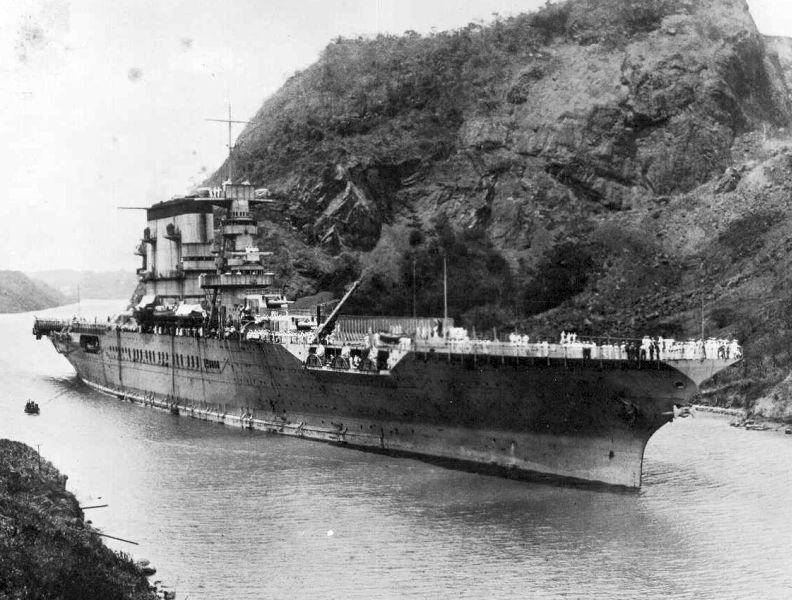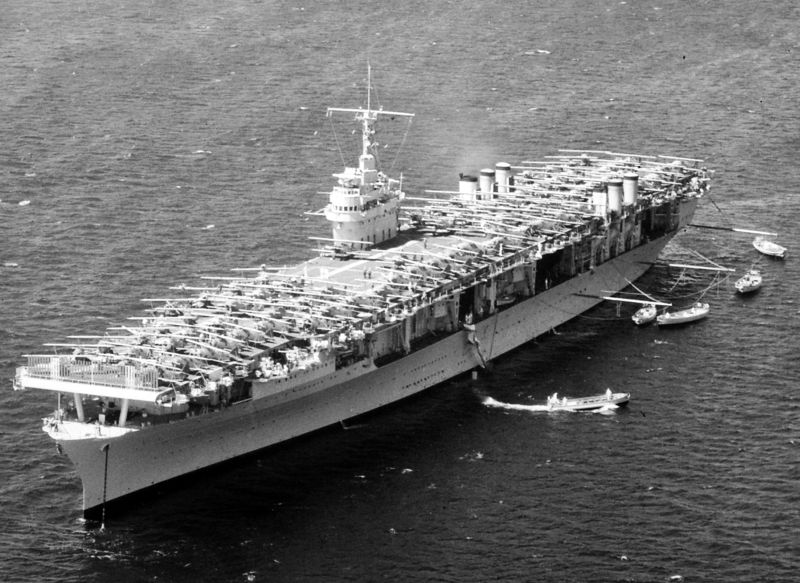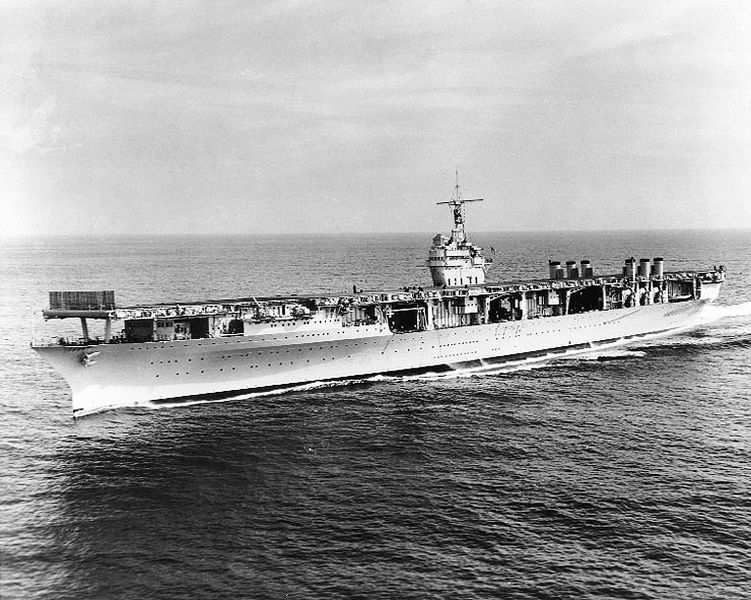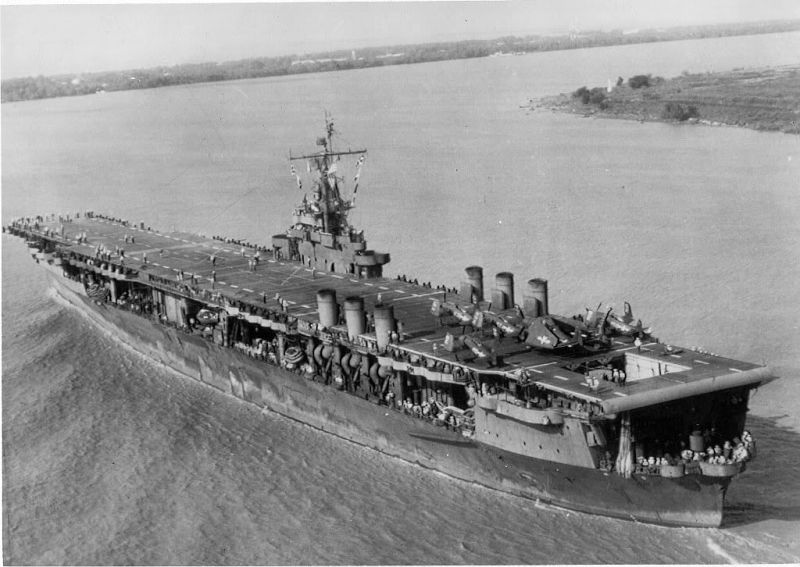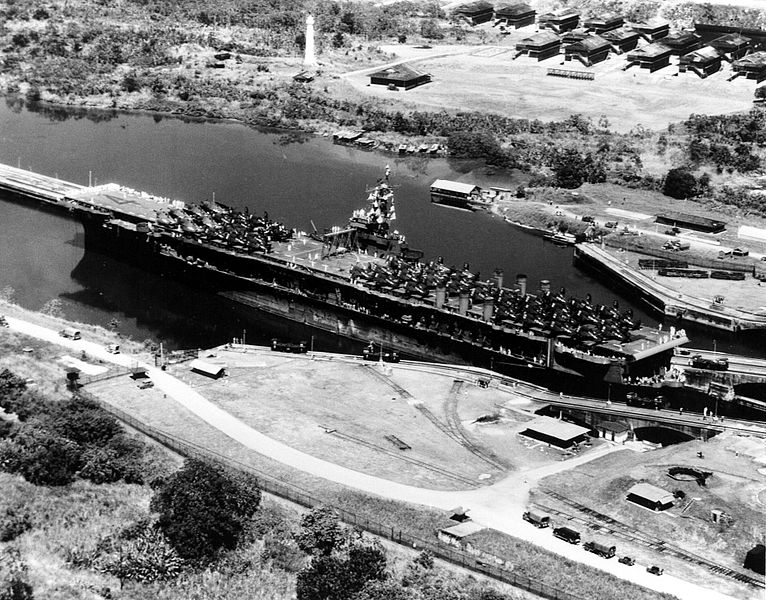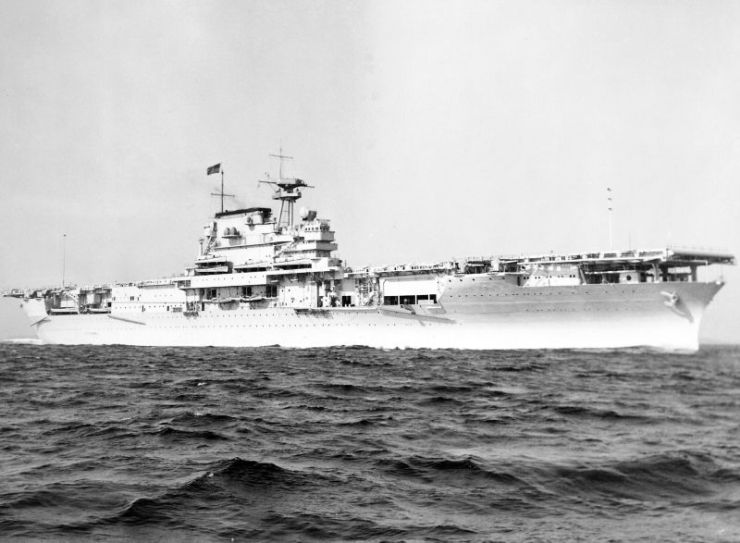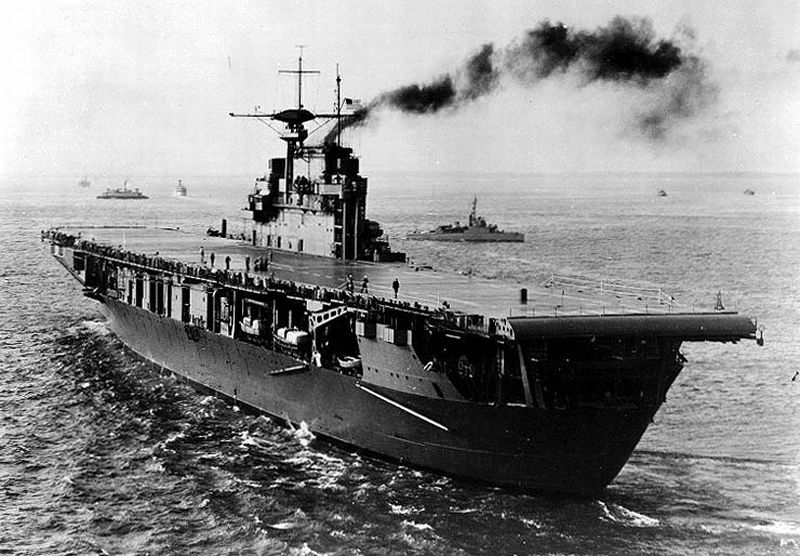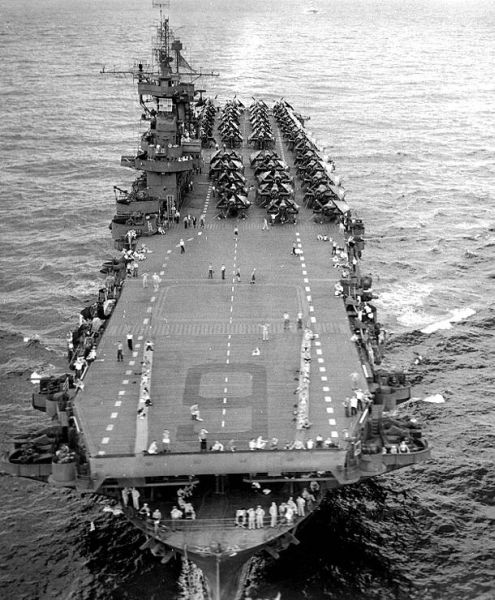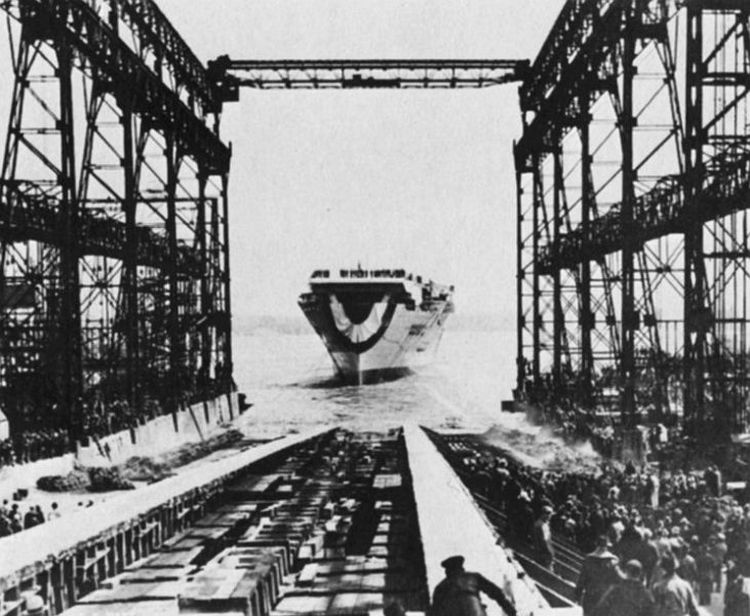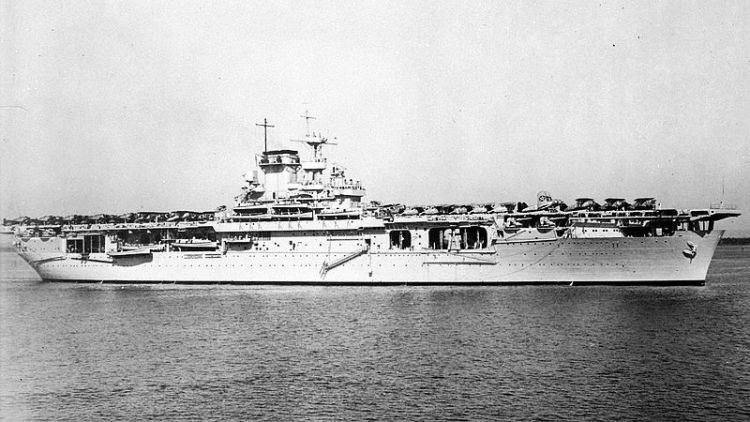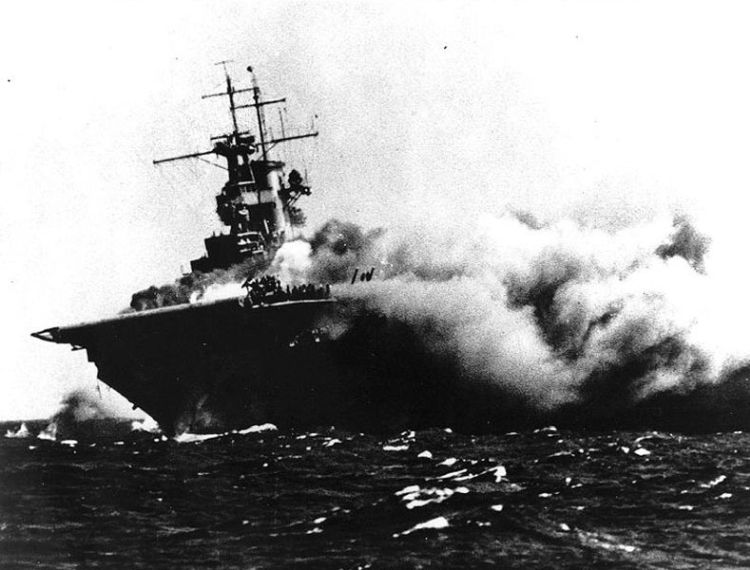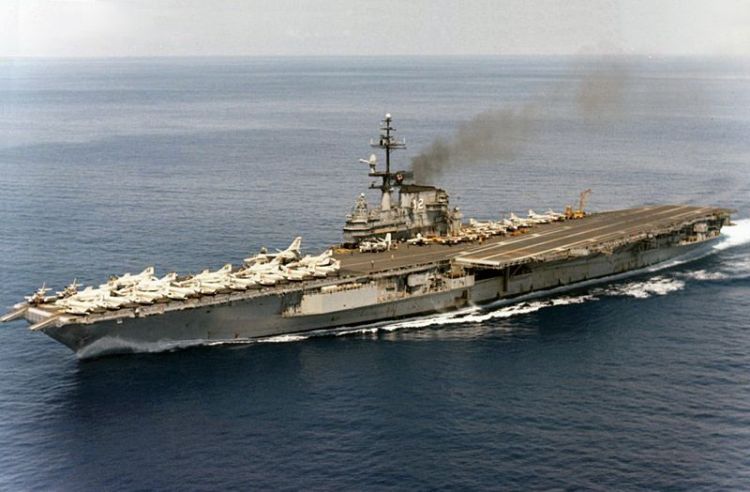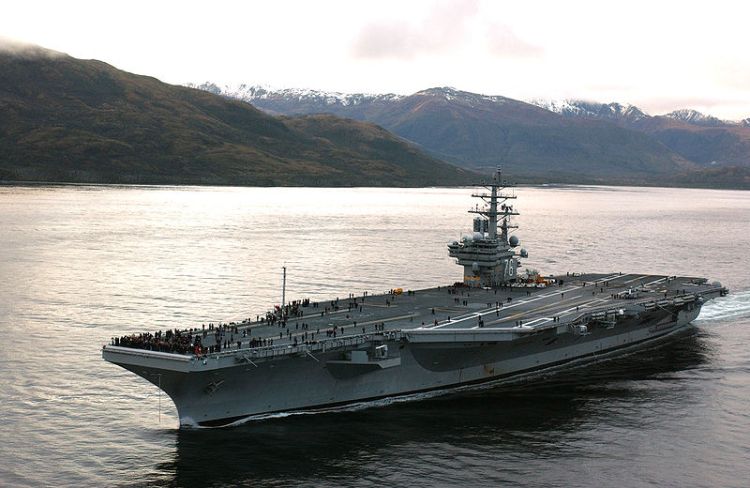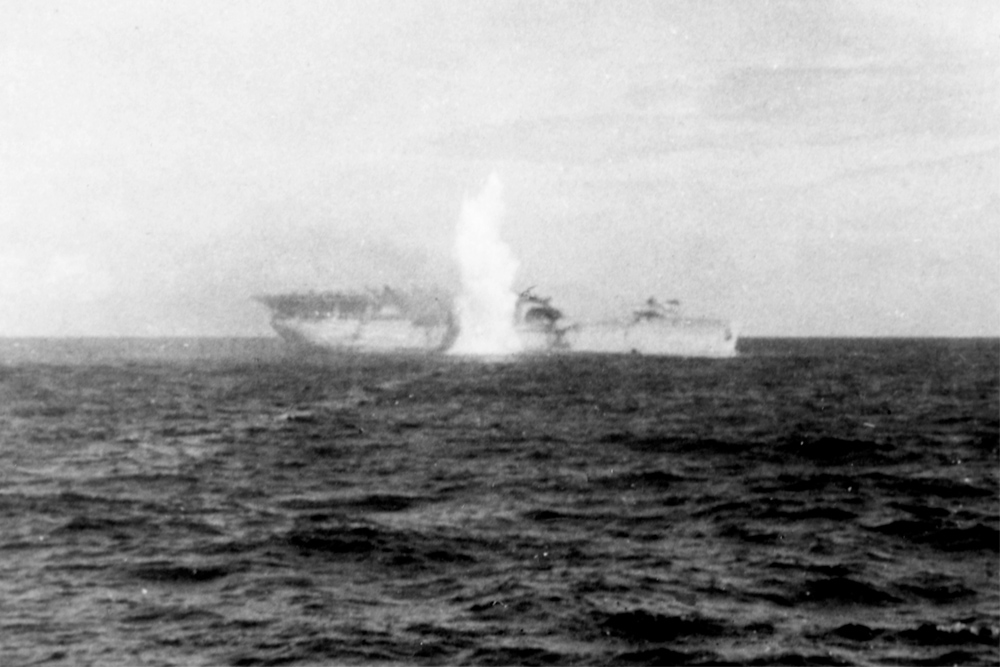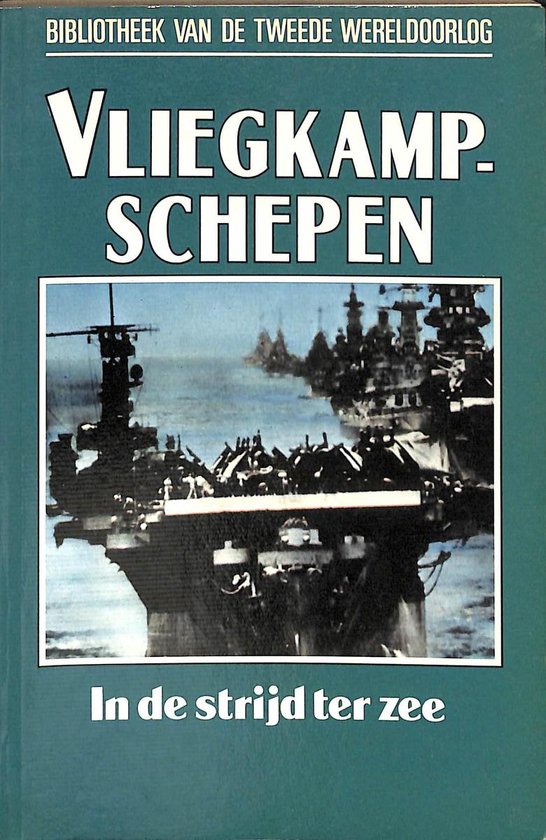Introduction
September 26, 1910, saw naval officer Captain Washington Irving Chambers named as liaison officer between all parties involved in the operatioonal deployment of aircraft by the US Navy. This appointment by Secretary of the Navy, George von Lengerke Meyer, can be considered the birth of American naval aviation. Chambers himslf was no advocate of a converted vessel equipped with a flight deck but attached more value to aircraft that could be launched from war ships by catapult. Cooperation between the US Navy and aircraft manufacturer Glenn Hammond Curtiss of the Curtiss Aeroplane Company led on November 14, 1910 to Eugene Ely, a civilian pilot, taking off in a Curtiss aircraft from a wooden ramp constructed on the bow of the light cruiser USS Birmingham (CL-2).
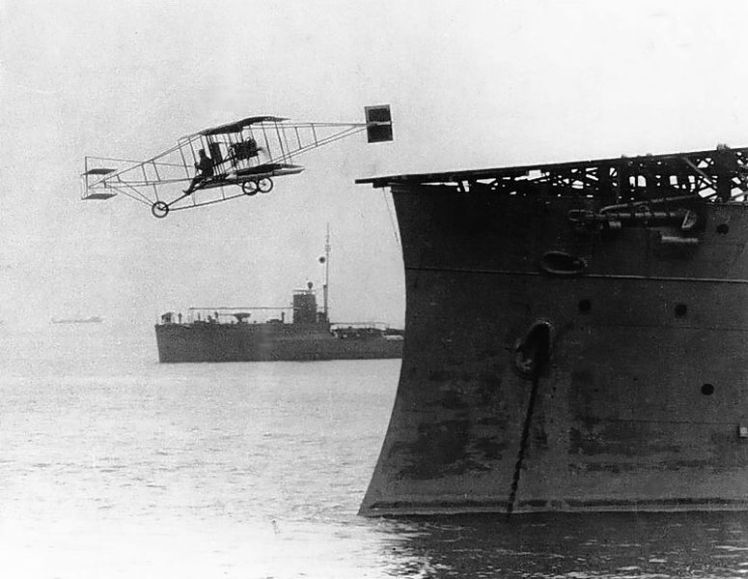
Eugene Ely takes off from the light cruiser USS Birmingham (CL-2), November 14, 1910. Source: Wikiprdia

Eugene Ely lands on the experimental flight deck of USS Pennsylvania (ACR-4), January 18, 1911. Source: Wikiprdia
This historical event unfolded in Hampton Roads, the entry to Chesapeak Bay, Virginia. After a short flight, Ely touched down safely on the Willoughby Spit peninsula near Norfolk. Eugene Ely also added the next historical achievement in aviation to his record. On January 18, 1911, he landed a Curtiss with a push propellor on a wooden platfom, specifically built for this occasion on the armored cruiser USS Pennsylvania (ACR-4) at anchor in San Francisco Bay. A little later he took off and landed his plane safely on Selfridge Field near San Francisco.
As Captain Chambers was an advocate of catapult launches, development of this method continued nonetheless. It would take until November 5, 1915 though, before Lieutenant-commander Henry C. Mustin would demonstrate the first successful catapult launch. That day, he was launched in his Curtiss AB-2 from the aft deck of the converted armored cruiser USS North Carolina (ACR-12). This new milestone in the history of American naval aviation took place in Pensacola Bay, Florida and was coordinated from the equally named naval airbase. After another number of launches from a warship at anchor, July 1916 saw the first launch from a ship in motion. The aircraft launched in this way had to be taken back on board using a crane though.

A successful catapult launch from the battle wagon USS North Carolina (ACR-12), 1916. Source: Wikiprdia
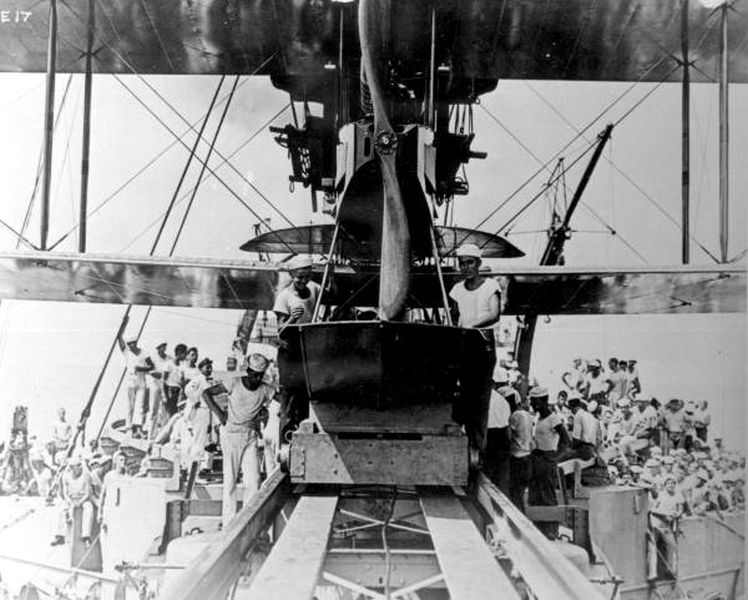
A Martin aircraft on the catapult of USS Huntington (CA-5), Pensacola, Florida. Source: Florida Memory
In 1918, the British showed that it was possible to land aircraft, equipped with a conventional undercarriage, on the continuous flight deck of an adapted vessel. In 1916, the Royal Navy had an ocean steamer, still under construction, converted to the first aircraft carrier in the world with a flat flight deck. This vessel was commissioned by the British Navy on September 16, 1918 as HMS Argus. Fourteen days later, a Sopwith Strutter landed safely on its deck. In December, 36 landings had been made successfully with Sopwith Strutters and Sopwith Pups. In this period, the British developed the catching wire which, in modern variations, is still in use on today's carriers. The Sopwith aircraft could still take off from the deck without a catapult though because of their low speed. In order to launch heavier aircraft, hydraulic catapults were developed later on. Using HMS Argus as an example, the US Navy had a coal transporter converted into an aircraft carrier and this vessel was baptized USS Langley (CV-1)
USS Langley (CV-1)
USS Langley (CV-1) was originally constructed as the coal transporter USS Jupiter for the American navy on the Mare Island Naval Shipyard in Vellejo in San Francisco Bay.
Conversion to aircraft carrier was approved on July 11, 1919 and on December 12 that year, the tender sailed to the Norfolk Naval Shipyard. On March 24, the vessel was taken out of service. The loading cranes were removed but the original bridge structure was maintained. Over the six large cargo holds and over the bridge, a flight deck made of wood was placed on a large steel construction. The cargo holds were used to store aviation fuel, disassembled aircraft, stores, reserve parts and the hydraulic elevator. The exhaust gasses were diverted to one, later two hinged chimneys on the port side. Assembled aircraft were lashed down on the cargo holds and could be moved to the flight deck by way of the elevator.
Technical data
| Builder: | Mare Island Naval Shipyard, Vellejo, California |
| Keel laid: | October 18, 1911 |
| Launched: | August 21, 1912 |
| Commissioned: | April 7, 1913 |
| Converted to carrier | from July 1919 on |
| Converted by: | Norfolk Naval Shipyard, Portsmouth, Virginia |
| Classified as carrier CV-1: | April 21, 1920 |
| Commissioned: | March 20, 1922 |
| Length overall: | 542 feet |
| Width overall: | 65 feet |
| Draught: | 22 feet |
| Standard displacement: | 11.500 BRT |
| Maximum displacement: | 15.150 BRT |
| Power plant: | General Electric turbo-electric, 3 boilers |
| Output: | 6.500 hp |
| Propellors: | 2 |
| Fuel capacity: | 2.249 U.S. short tons of fuel oil |
| Range: | 14.000 nautical miles at 10 knots |
| Maximum speed | 15.5 knots |
| Crew: | 468 men |
| Armament: | 4 12,5cm 51-caliber guns |
| Flight deck facilities: | 1 aircraft elevator, 1 hydraulic catapult |
| Aircraft: | In total 34 Vought VE-7 biplanes |
After the first American carrier had been commissioned as USS Langley (CV-1) on March 20, 1922, the US Navy could start training take offs from and landings on a flight deck. With the arrival of the Langley, a whole new era began, one of experimenting and gaining experience with a purpose built vessel but also one of carriers that steadily grew larger and faster, based on USS Langley.
On October 17, 1922 Lieutenant V.C. Griffin took off safely in a Vought VE-7SF from the flight deck of the Langley. Nine days later, Lieutenant-commander Godfrey Chevalier landed on the Langley in an Aeromarine aircraft. Shortly after, more testing was done with comparable aircraft but then the ship was at sea. On November 18. 1922, Commander Kenneth Whiting in a PT sea plane was launched by hydraulic catapult for the first time from the first American carrier.
From 1924 onwards, the Langley participated in fleet exercises in which aircraft played an increasingly more important role. From that year until 1936, the Langley was stationed in California and from there, the vessel served as a training ship for pilots and took part in fleet exercises.
In 1936, the Langley was converted to a sea plane tender as she no longer matched the requirements of an aircraft carrier. Conversion was carried out by the shipyard where she was originally constructed as Jupiter and was given the new bow sign AV-3. When the US were drawn into the Second World War on December 7, 1941, USS Langley(AV-3) was at anchor near Cavite on the Philippines. After the Japanese invasion of these islands, the old vessel was diverted to the Dutch East Indies. From there, USS Langley left for Darwin, Australia where she arrived on January 1, 1942.
Some 11 days later, she set sail for Fremantle to take aboard 32 ready-to-fly American Curtiss P-40 fighters and a number of them in crates, destination Tjilatjap on the island of Java. She was accompanied by the freighter Sea Witch which also carried P-40 fighters in crates. Escorted by the destroyers USS Whipple and Esdall, (actually, the Dutch mine layer Hr. Ms. Willem van der Zaan was to escort both vessels as well, but she had to miss out because of boiler problems), on February 27, both transporters came under attack from nine Japanese dive bombers, 75 miles south of Tjilatjap. The Langley was struck by five bombs which knocked her out of action and she was abandoned by her crew. The destroyers fired four shells and two torpedoes at the old vessel to prevent her from falling into enemy hands. Shortly before, the crew and P-40 pilots had been taken aboard both destroyers and the old tanker USS Pecos. Most of them lost their lives anyway as both destroyers were sunk by Japanese bombs. Sea Witch was spared and could deliver her cargo in Tjilatjap. After the fall of Java on March 8, 1942, the crates containing the airplanes had to be destroyed nonetheless so they wouldn't fall into Japanese hands
Definitielijst
- caliber
- The inner diameter of the barrel of a gun, measured at the muzzle. The length of the barrel is often indicated by the number of calibers. This means the barrel of the 15/24 cannon is 24 by 15 cm long.
- invasion
- Armed incursion.
- mine
- An object filled with explosives, equipped with detonator which is activated by either remote control or by colliding with the targeted object. Mines are intended to destroy of damage vehicles, aircrafts or vessels, or to injure, kill or otherwise putting staff out of action. It is also possible to deny enemy access of a specific area by laying mines.
From CV-1 to CV-4
On July 1, 1922, US Congress approved the conversion of the battle cruisers USS Lexington and Saratoga still under construction to aircraft carriers On February 6 of the same year, the US had signed the Washington Fleet Agreement. In it, the United States, Great Britain, Japan, France and Italy, being the most important maritime powers in the world, agreed to curtail the naval arms race. From that moment on, a maximum tonnage was imposed on each country. To the US it meant that the navy was allowed to operate aircraft carriers up to a total tonnage of 133,000 BRT. As USS Langley was considered experimental, she was excluded from the calculation. Both vessels of the Lexington class were limited to a standard displacement of 33,000 BRT and therefore took a large bite out of the allowed maximum.
The Lexington class battle cruisers would have a standard displacement of 43,000 BRT. Moreover, they would be equipped with a power plant generating 180,000 hp, propelling the warships at a maximum speed of 33 knots. These were excellent specifications which could form a foundation for aircraft carriers. With this, the US navy took a giant step forward from the Langley displacing over 11,500 BRT to the Lexington class carriers three times as large. Because this step was successful, it resulted in an enormous head start in the development of carriers.
Actually, six battle cruisers of the Lexington class would be constructed but four were annulled, pursuant to the Washington Treaty. The four battle cruisers already under construction were demolished in 1923. The material destined for the battle cruiser Ranger was used however in the construction of the carrier USS Ranger. USS Langley (CV-1), Lexington (CV-2), and Saratoga (CV-3) were still vessels converted to carriers whereas USS Ranger (CV-4) was the first American carrier designed and constructed as such. As the US navy still lacked experience designing a carrier, the Ranger was no outright success. The vessel was too slow and too vulnerable. This was mainly because the boilers were located in the rear of the ship and this was chosen to have an exhaust pipe as short as possible but owing to a lack of armor in the rear of the vessel, the carrier could be knocked out by a single torpedo hit.
The design initially foresaw in a flight deck without obstacles but later on, a small bridge island was added. As the narrow hull of the Ranger ended in a broad flight deck, stability of the carrier wasn't at its best and the bridge island only made matters worse. The fine lines of the hull had been designed to improve the speed of the carrier but owing to her length, she regularly dived deep into the waves in bad weather, hence the incoming spray caused lots of trouble aboard. Due to her limitations, USS Ranger (CV-4) was hardly deployed on offensive missions during World War Two.
Definitielijst
- offensive
- Attack on a smaller or larger scale.
- Ranger
- American name for a specially trained soldier (similar to commando).
- torpedo
- A weapon of war. A cigar shaped body fitted with explosives and a propulsion and control mechanism. Intended to target after launch a nearby enemy ship and disable it by underwater explosion.
USS Ranger
Technical data
| Builder: | Newport News Shipbuilding & Drydock Co., Newport News, Va. |
| Keel laid: | September 26, 1930 |
| Launched: | February 25, 1933 |
| Commissioned: | June 4, 1934 |
| Length overall: | 740 feet |
| Width overall: | 110 feet |
| Draught: | 22 feet |
| Standard displacement: | 14,576 BRT |
| Maximum displacement: | 17,577 BRT |
| Power plant: | Curtis & Parsons steam turbines, 6 x Babcock & Wilcox Express type boilers |
| Output: | 53,500 pk |
| Propellors: | 2 |
| Fuel capacity: | 1,758 U.S. short tons of fuel oil |
| Range: | 10,000 nautical miles at 15 knots |
| Maximum speed | 29 knots |
| Crew according to specification: | 1,788 men including air crews |
| Crew during WW 2: | 2,461 men including flight crews |
| Armor: | 51mm belt- and 25mm flight deck armor |
| Armament: | 8 12.5cm 25-caliber guns, 40 .50 machineguns |
| Flight deck facilities: | 3 aircraft elevators, 3 hydraulic catapults |
| Aircraft: | In total 76 Curtiss BF2C Goshawk or Grumman F2F fighters, Great Lakes BG dive bombers and Martin XT6M torpedo aircraft |
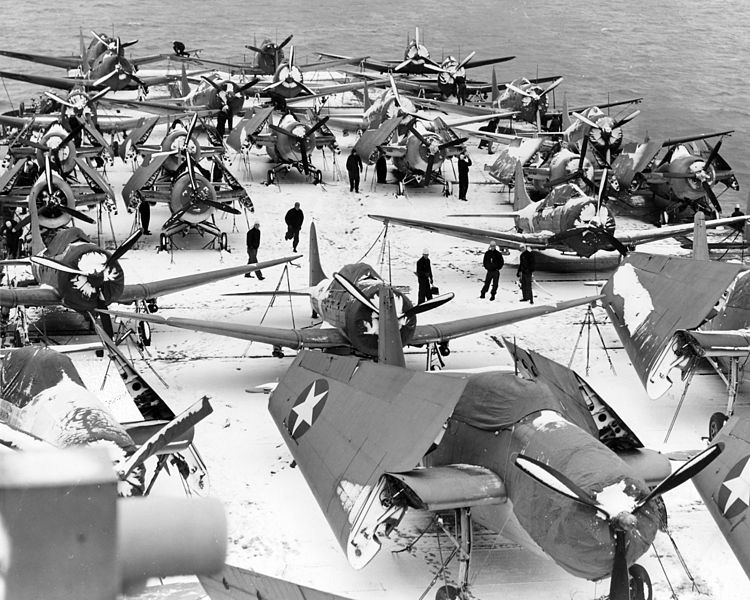
USS Ranger on the North Atlantic carrying Grumman TBF Avengers and F4F Wildcats, June 1943. Source: Wikipedia
USS Ranger (CV-4) set sail on august 17, 1934 for a test run and a flag display voyage which brought her to Rio de Janeiro, Buenos Aires and Montevideo. She returned to Norfolk on October 4 that year for flight exercises which lasted until the end of March 1935. Subsequently she sailed through the Panama Canal and arrived in San Diego on April 15. She took part in fleet exercises from this base during four years. On January 4, 1939, the carrier set sail from San Diego to the Caribbean, taking part in winter exercises from Guantanamo Bay, Cuba. From the outbreak of World War Two on September 3, 1939, she ran neutrality patrols in the Atlantic from Bermuda. During the Japanese attack on Pearl Harbor, she was on her way from Trinidad to Norfolk returning from an ocean patrol; she arrived the next day. Another patrol, lasting until March 22, 1942 in the south Atlantic followed after which the carrier returned for refitting.
In the spring and summer of 1942, USS Ranger transported Curtiss P-40 fighters to Accra in the British Crown Colony of Gold Coast, today Ghana. From October 1, 1942, she held exercises from Bermuda with four new Sangamon class escort carriers. From November 8, 1942, she and the four escorts lent air support to the Allied invasion in North-Africa. After four days, she returned to Norfolk for a major overhaul.
On February 23, 1943 USS Ranger arrived in Casablanca, Morocco with a load of 75 P-40 fighter planes for the USAAF in North-Africa. In the spring of 1943, she served as training vessel for new pilots off the coast of New England. From August 19 onwards, the American carrier was part of the British Home Fleet in Scapa Flow, Scotland. Along with British war ships she patrolled British waters and attacked German vessels off the Norwegian coast. On December 4, she returned to the US, again to serve as training vessel until April 20, 1944. Thereafter, she carried P-38 fighters and American and French navy personnel to North-Africa and transported damaged USAAF aircraft back to New York for repairs.
From May 1944 onwards, she was refitted on the Norfolk Navy shipyard. In this period, her flight deck was reinforced and a new deck catapult and radar were installed. On July 11, 1944, she set sail from the shipyard in Virginia and steamed through the Panama Canal five days later.
Nine days later she arrived in San Diego and sailed on to Pearl Harbor. Based in Hawaii, she served as training vessel for three months, training pilots to make night landings. Until the end of the war, she served as a training ship from the San Diego base. On October 18, 1945 she arrived at the Philadelphia Naval shipyard for repairs and afterwards she took part in fleet exercises in the Atlantic Ocean. On October 18, 1946, she was decommissioned and 11 days later she was taken off the America navy register. On January 28, 1947, the discarded carrier was sold to the Sun Shipbuilding & Drydock Co. in Chester, Pa.
USS Ranger was awarded two Battle Stars for her performance during the war.
Definitielijst
- caliber
- The inner diameter of the barrel of a gun, measured at the muzzle. The length of the barrel is often indicated by the number of calibers. This means the barrel of the 15/24 cannon is 24 by 15 cm long.
- invasion
- Armed incursion.
- neutrality
- Impartiality, absence of decided views, the state of not supporting or helping either side in a conflict.
- radar
- English abbreviation meaning: Radio Detection And Ranging. System to detect the presence, distance, speed and direction of an object, such as ships and airplanes, using electromagnetic waves.
- Ranger
- American name for a specially trained soldier (similar to commando).
- torpedo
- A weapon of war. A cigar shaped body fitted with explosives and a propulsion and control mechanism. Intended to target after launch a nearby enemy ship and disable it by underwater explosion.
From CV-4 to CV-8
As the US Navy had gained positive experiences with the large Lexington class carriers, it was decided to use the 55,000 tons which, according to the Washington Treaty, was still available, to build two large carriers of over 20,000 BRT. This tonnage was considered sufficient to construct a carrier capable of operating with just as many aircraft as the Lexington. Moreover, this displacement would be sufficient to equip the vessels with armor according to the standards of the time. The successor to the Lexington class was the Yorktown class with a standard displacement of 20,100 BRT. USS Yorktown entered service in 1937 and USS Enterprise followed a year later. The vessels proved to be very successful. They were fast, maneuverable, equipped with heavy armament, well armored, well protected below the water line and could fly off over 80 aircraft.
In 1937, Japan announced she wouldn't honor the agreements in the second London Fleet Treaty, the successor of the first London Fleet Treaty and the Washington Fleet Treaty any longer. For all countries involved, this meant that all agreements were cancelled and shortly before the Second World War, a new maritime arms race unfolded. To the US Navy, this meant the keel of a third Yorktown class carrier could be laid. This became the USS Hornet (CV-8). The bow sign CV-7 was already in use by the light carrier USS Wasp which had taken up the last remaining 15,000 BRT of the Washington Treaty. Despite the US Navy knowing that a smaller carrier would have less battle value, it wouldn't let the last available tons of the treaty slip by.
USS Yorktown (CV-5), USS Enterprise (CV-6) and USS Hornet (CV-8), together with USS Lexington (CV-2) and USS Saratoga (CV-3), made up the backbone of the American navy during the first years of World War Two. USS Ranger (CV-4) and Wasp were only deployed on smaller defensive missions. Out of these seven carriers, only Saratoga, Ranger and Enterprise would survive the war. USS Lexington was lost on May 8, 1942 during the Battle of the Coral Sea, USS Yorktown was sunk during the Battle of Midway on June 7 of the same year. USS Wasp was torpedoed in the Pacific on September 15 and USS Hornet was sunk on October 26, 1942 during the Battle of Santa Cruz.
USS Wasp was in fact a scaled-down version of the Yorktown carriers. The designers of the American navy wanted to cram as many aircraft as possible on a vessel with over 25% less displacement than her example. This was directly at the cost of armor and speed. What made USS Wasp most vulnerable was the lack of protection below the water line. Therefore, Wasp wasn't a great success and the light carrier could only be deployed in secondary tasks. The carrier however was equipped with an aircraft elevator fixed to the edge of the flight deck, a so-called deck edge elevator; the first American carrier equipped as such.
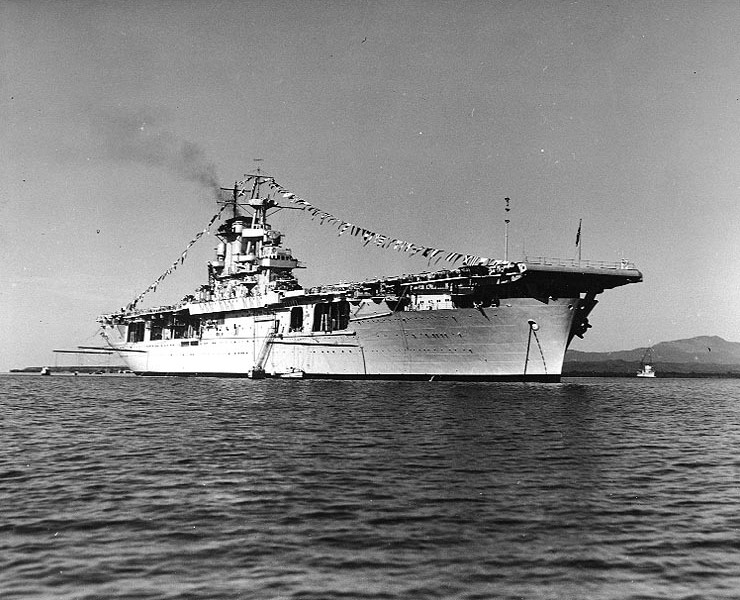
USS Wasp (CV-7) in Guantanamo Bay, October 27, 1940. The design has obviously been derived from the Yorktown class carriers. Source: Courtesy of Michael W. Pocock
Definitielijst
- Midway
- Island in the Pacific where from 4 to 6 June 1942 a battle was fought between Japan and the United States. The battle of Midway was a turning point in the war in the Pacific resulting in a heavy defeat for the Japanese.
- Ranger
- American name for a specially trained soldier (similar to commando).
USS Wasp (CV-7)
Technical data
| Builder: | Fore River Shipyard in Quincy, Massachusetts |
| Keel laid: | April 1, 1936 |
| Launched: | April 4, 1939 |
| Commissioned: | April 25, 1940 |
| Length overall: | 574 feet |
| With overall: | 84 feet |
| Draught: | 15 feet |
| Standard displacement: | 14,700 BRT |
| Maximum displacement: | 18,450 BRT |
| Power plant: | Parsons steam turbines, 6 Yarrow boilers |
| Output: | 70,000 hp |
| Propellors: | 2 |
| Fuel capacity: | 3,756 U.S. short tons of fuel oil |
| Range: | 12,000 nautical miles at 15 knots |
| Maximum speed | 29.5 knots |
| Crew according to specification: | 1,800 men including air crews |
| Crew during WW 2: | 2,167 men including air crews |
| Armor: | 16 tot 19mm belt- and 32mm flight deck armor |
| Armament: | 8 12.cm 38-caliber guns, 4 28mm and 24 .50 (12,7mm) machineguns |
| Flight deck facilities: | 3 aircraft elevators, 4 hydraulic catapults |
| Aircraft: | In total 76 Brewster F2A Buffalo or Grumman F2F fighters, Vought SB2U Vindicator or Curtiss SBC Helldiver dive bombers and Douglas TBD Devastator torpedo bombers |
After her crew had been run in, the carrier was tasked with neutrality patrols in the Atlantic. In April 1942, she was temporarily assigned to the British Home Fleet, transporting war planes to Malta twice. In June of that year however, the light carrier was assigned to the US Pacific Fleet. Despite her vulnerability, her flight deck was badly needed following the loss of USS Enterprise as well as USS Yorktown. In the summer of 1942, she was involved in the invasion of Guadalcanal by giving air cover together with the carriers USS Lexington and Yorktown.
On Tuesday, September 15, 1942, USS Wasp, USS Hornet and the cruiser USS North Carolina and 10 other warships escorted a flotilla of transport vessels. These carried the 7th Marine Regiment to Guadalcanal for reinforcement. While she was launching 8 Wildcats and 18 Dauntless dive bombers, the Japanese submarine I-19 fired a salvo of six torpedoes at the carrier at 14:44. One minute later, she was struck by three of the six torpedoes, causing a series of explosions aboard the carrier, mainly in the forecastle. The explosions in turn triggered a chain reaction of fire and exploding Flak ammunition and bombs.
The carrier was soon listing 10 to 15 degrees to starboard and leaking oil and aviation fuel caused a sea of flames on the water. Twenty-four minutes after being hit, three fuel vapor explosions occurred simultaneously and her commander, Captain Forest P. Sherman ordered to abandon ship. At 16:00 the entire crew had left the carrier and the survivors were picked up by the destroyers USS Laffey, Lansdowne and the cruisers USS Helenaand Salt Lake City. Later that night, Lansdowne was ordered to sink the burning wreck of the Wasp with torpedoes. The loss of USS Wasp claimed 193 dead and 366 injured.
Definitielijst
- caliber
- The inner diameter of the barrel of a gun, measured at the muzzle. The length of the barrel is often indicated by the number of calibers. This means the barrel of the 15/24 cannon is 24 by 15 cm long.
- Flak
- Flieger-/Flugabwehrkanone. German anti-aircraft guns.
- Guadalcanal
- First island in the Pacific liberated by US forces from the Japanese during World War 2. Between August 1942 and February 1943 a number of confrontations on land, at sea and in the air took place on this island.
- invasion
- Armed incursion.
- neutrality
- Impartiality, absence of decided views, the state of not supporting or helping either side in a conflict.
- Regiment
- Part of a division. A division divided into a number of regiments. In the army traditionally the name of the major organised unit of one type of weapon.
- torpedo
- A weapon of war. A cigar shaped body fitted with explosives and a propulsion and control mechanism. Intended to target after launch a nearby enemy ship and disable it by underwater explosion.
From CV-9 to CVN-78
President Franklin D. Roosevelt and the American navy already knew at the end of 1940 that the seven carriers, at that moment in service with the US Navy, were not sufficient to face the enemy, should the US become involved in the Second World War. The delivery of USS Hornet (CV-8) could do little to improve the situation. Only the accelerated construction of the planned Essex class carriers and the conversion of light cruisers still being built could be the solution. In a reaction, the Navy indeed stepped up the construction of the Essex class and the nine light cruisers of the Cleveland class were converted to the light carriers of the Independence class. With the nine vessels of this class and the 18 Essex class carriers that would enter service in the course of the war, the US Navy enjoyed numerical superiority in carriers as compared to the Japanese Imperial Navy.
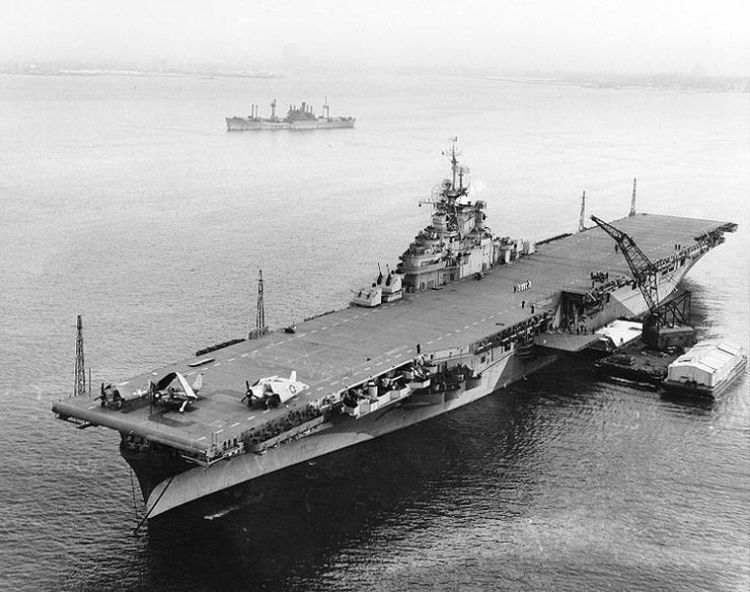
The Independence class light carrier USS San Jacinto off the American east coast, January 23, 1944. Source: Navsoure
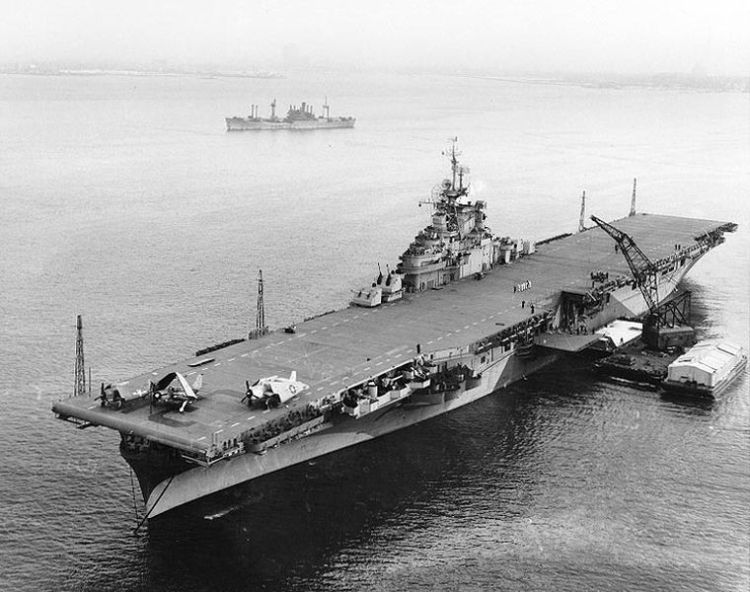
The Essex classs USS Bon Homme Richard (CV-31) in New York, January 9, 1945. Source: Courtesy of Michael W. Pocock
After the war, another six Essex class carriers were commissioned and three larger vessels of the Midway class (45,000 BRT): USS Midway (CV-41), USS Franklin D. Roosevelt (CV-42) and USS Coral Sea (CV-43). The Midway would remain in service until 1992 after having carried out her last missions during the Gulf War of 1991. The Midway class was succeeded by the first of the so-called super carriers of the Forrestal class (60,000 BRT): USS Forrestal] (CV-59), USS Saratoga (CV-60), USS Ranger (CV-61) and USS Independence (CV-62). The first two vessels of this class have been demolished in early 2014, the others have been mothballed, waiting to be dismantled.
During the 60s, the Forrestal class was succeeded by the super carriers of the Kitty Hawk class with the same tonnage but with many practical improvements. The vessels in this class were: USS Kitty Hawk (CV-63), USS Constellation (CV-64 ) and USS America (CV-66). USS John F. Kennedy (CV-67) was a variation of this class and is sometimes considered a subclass. At the same time as the vessels of the Kitty Hawk class, USS Enterprise (CVN-65) was built. This was the first nuclear powered super carrier in the world with a displacement of over 94,000 BRT. She was considered an experimental vessel by the US Navy but the carrier remained in service for over 50 years.
The Kitty Hawk class and the Enterprise were followed in the mid-70s by the 10 nuclear powered super carriers of the Nimitz class of over 100,000 BRT. The class consisted of:
- USS Nimitz (CVN-68)
- USS Dwight D. Eisenhower (CVN-69)
- USS Carl Vinson (CVN-70)
- USS Theodore Roosevelt (CVN-71)
- USS Abraham Lincoln (CVN-72)
- USS George Washington (CVN-73)
- USS John C, Stennis (CVN-74)
- USS Harry S. Truman (CVN-75)
- USS Ronald Reagan (CVN-76)
The last carrier of this class was commissioned on January 10, 2009 as USS George H.W. Bush (CVN-77). All these vessels are still in active service. From 2016, this class will be followed up by the Gerald R. Ford class and the keel of the first one, USS Gerald R. Ford (CVN-78), was laid on November 13, 2009 on the wharf of the Newport News Shipbuilding in Newport News, Va.
The US Navy is the only maritime power in the world that can keep super carriers in service. The lead in technical development of carriers that the navy has taken with the Essex class vessels has never been lost. During the Cold War, the Soviet Union could keep up somewhat but from the 90s onwards the Americans are the ultimate masters at sea as to military striking power.
Definitielijst
- mid
- Military intelligence service.
- Midway
- Island in the Pacific where from 4 to 6 June 1942 a battle was fought between Japan and the United States. The battle of Midway was a turning point in the war in the Pacific resulting in a heavy defeat for the Japanese.
- Soviet Union
- Soviet Russia, alternative name for the USSR.
Information
- Article by:
- Peter Kimenai
- Translated by:
- Arnold Palthe
- Published on:
- 26-07-2023
- Last edit on:
- 29-07-2023
- Feedback?
- Send it!
Related sights
Related books
Sources
- IRELAND, B., Vliegdekschepen, Veltman Uitgevers, Utrecht, 2007.
- LYON, H, Encyclopedie van de belangrijkste oorlogsschepen ter wereld, Scriptoria, Antwerpen, 1980.
- MACINTYRE, D., Vliegkampschepen, Standaard Uitgeverij Antwerpen, Antwerpen, 1989.
- MCCURTIE, F.E., Jane`s Fighting Ships of World War II, Military Press, New York, 1989.
- www.navsource.org
- www.history.navy.mil
- www.maritimequest.com
- www.historycentral.org
- www.ibiblio.org
- www.en.wikipedia.org
- www.uboat.net
Visitor`s Guide Patriots Point
